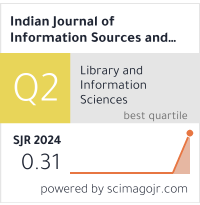Bradford’s Law in the Field of Psychology Research in India
DOI:
https://doi.org/10.51983/ijiss-2021.11.2.2939Keywords:
Psychology, India, Countries, Scientometric, Web of Science (WoS), Bradford’s Law, Bradford’s Multiplier, Leimkuhler ModelAbstract
The main objective of this investigation is to know the applicability of Bradford’s law in Psychology research in India. A total of global wise 14,30,700 papers has be published and 12,543 (0.88%) with 96,871 published in India than retrieved from the “Web of Science” citation database for a time of twenty years i.e. from 2001 to 2020. The study examined the countries wise research output, communication channels preferred by the researchers, and most productive journals in Psychology literature. The analysis of the study revealed that there is an increasing trend in terms of research productivity during the period. USA 5,11,528 (35.75%) Psychology research publications followed by England with 1,32,460 (9.26%) Germany96,620 (6.75%), Canada country 75,238 (5.26%), China and Spain both countries 2.49% research paper published and seven and eight stage ranked and India country psychology research papers published with 12,543 (0.88%) eighteenth ranked. The maximum number of research papers are published by Indian Journal of Psychiatry 4,316 (34.49%) and 3,909 (4.04%) citations first ranked followed by Asian Journal of Psychiatry 772 (6.17%) papers, 2,835 citations. The percentage of the error is negative and negligible (-0.00870), therefore the data conforms well fit to Bradford’s law zone.
References
Amsaveni, N. (2016). Assessment of Bradford Law’s of Scattering to Neural Network Literature through Bibliometric Study. International Journal of Next Generation Library and Technologies, 2(3), 1-15.
Banateppanavar, K., & Dharanikumar, P. (2014). Bradford’s Zone to LIS Publications Published in Library Management Journal from 2010-2012: A Citation Study. Library Philosophy and Practice, 1091.
Bradford, S. C. (1934). Sources information on specific subjects. Engineering, 85-86.
Brookes, B. C. (1969). Bradford’s Law and the Bibliography of Science. Nature, 224, 953-956.
Chaman, S. M., & Kumar, P. D. (2018). Bradford’s Law: Identification of the Core Journals in the Field of Indian Chemical Science Literature. International Journal of Information Dissemination and Technology, 8(2), 104-110.
Egghe, L., & Rousseau, R. (2006). An informetric model for the Hirsch-index. Scientometrics, 69(1), 121–129.
Egghe, L. (1990). A Note on Different Bradford Multipliers. Journal of the American Society for Information Science, 41(3), 204-209.
Fernald, D. L. (2008). Psychology. Thousand Oaks, CA: Sage Publications.
Hjorland, B., & Nicolaisen, J. (2005). Bradford’s Law of Scattering: Ambiguities in the Concept of “Subject”. Springer-Verlag Berlin Heidelberg, 96-106.
Hockenbury, D. H., & Hockenbury, S. E. (2010). Psychology. (5th, Ed.) Worth Publishers.
Kumar, S. (2014). Application of Bradfords law to Human- Computer Interaction Research Literature. DESIDOC J. Libr. Information Technol, 34(3), 223-231.
Kumar, S., & Senthilkumar, R. (2018). Application of Bradford’s law of scattering on research publication in Astronomy & Astrophysics of India. Library Philosophy and Practice, 2037.
Leimkuhler, F. F. (1967). The Bradford Distribution. Journal of Documentation, 23(3), 197-207.
Nash-Stewart, C. E., Kruesi, L. M., & Del Mar, C. B. (2012). Does Bradford’s Law of Scattering predict the size of the literature in Cochrane Reviews? Journal of the Medical Library Association: JMLA, 100(2), 135.
Neelamma, G., & Anandhalli, G. (2016). Application of Bradford’s law in the field of botany literature from 2005 to 2014: A citation analysis. International Journal of Library and Information Science, 8(5), 36-47.
Neelamma, G., & Anandhalli, G. (2016). Application of Bradford’s Law in the Field of Crystallography: A Scientometric Study. International Journal of Information Dissemination and Technology, 6(2), 77-83.
Ram, S., & Paliwal, N. (2014). Assessment of Bradford Law’s of Scattering to Psoriasis Literature through Bibliometric Snapshot. DESIDOC Journal of Library & Information Technology, 34(1).
Sab, C., Dharani Kumar, P., & Biradar, B. S. (2018). Bradford’s Law: Identification of the Core Journals in the Field of Indian Chemical Science Literature. International Journal of Information Dissemination and Technology, 8(2), 2-18.
Sudhier, K. G. (2010). Application of Bradford’s Law of Scattering to the Physics Literature: A Study of Doctoral Thesis Citations at the Indian Institute of Science. DESIDOC Journal of Library & Information Technology, 30(2), 3-14.
Venable, G. T., Shepherd, B. A., Roberts, M. L., Taylor, D. R., Khan, N. R., & Klimo, P. (2014). An application of Bradford’s law: identification of the core journals of pediatric neurosurgery and a regional comparison of citation density. Child’s Nervous System, 30(10), 1717-1727.
Downloads
Published
How to Cite
Issue
Section
License
Copyright (c) 2021 The Research Publication

This work is licensed under a Creative Commons Attribution-NonCommercial-NoDerivatives 4.0 International License.









